Overview
In the demanding world of healthcare, providers often face emotional challenges that can hinder their ability to deliver the best care possible. The administrative burdens they encounter can weigh heavily, impacting their focus on patient interactions. It’s crucial to address these concerns with effective solutions.
A patient chart template can be a powerful tool in this regard. Key features to consider include:
- Standardized formats that ensure consistency across records.
- Essential components that provide comprehensive health information.
- Customization options tailored to meet the specific needs of different practices.
- Integration of AI tools to streamline documentation and billing processes.
These features are designed not just to enhance efficiency but also to improve the quality of care provided to patients. By reducing the administrative workload, healthcare providers can spend more time nurturing their patient relationships, ultimately leading to better outcomes.
As you explore these templates, reflect on how they might alleviate some of the pressures you face daily. Consider engaging with resources that can support you in implementing these solutions, fostering a more compassionate and effective healthcare environment.
Introduction
In the intricate world of healthcare, where every second counts and patient care is paramount, the efficiency of administrative tasks can often feel overwhelming. This burden can weigh heavily on healthcare providers, impacting the quality of care they deliver. A well-designed patient chart template emerges as a vital solution, offering a streamlined approach to managing patient information. These templates not only enhance workflow efficiency but also hold the potential to improve patient outcomes significantly.
As the healthcare landscape evolves with the integration of AI and telehealth, providers face the challenge of adapting their charting practices. How can they meet the demands of modern care while ensuring accuracy and compassion? This article delves into the essential features that patient chart templates should possess, inviting you to explore how they can transform your practice and support your commitment to patient care.
CosmaNeura: AI-Driven Administrative Efficiency for Patient Charts
Healthcare providers often face overwhelming emotional challenges due to the demands of their roles. The burden of administrative tasks, such as managing a patient chart template, can detract from their primary focus on patient care. CosmaNeura's AI platform offers a compassionate solution by automating essential administrative processes like intake and triage. This not only alleviates stress but also allows medical professionals to dedicate more time to their patients, ultimately enhancing the quality of care provided.
Imagine spending over four hours each day on administrative duties. This statistic highlights the urgent need for effective solutions that can lighten this load. By streamlining workflows, CosmaNeura's platform minimizes the potential for errors associated with manual data entry, fostering greater accuracy and efficiency. As we look ahead to 2025, the integration of AI in administrative tasks is expected to further improve these workflows, allowing practitioners to reclaim precious time and focus on delivering compassionate care.
The positive impact of automation on healthcare provider workflows is clear. Many professionals express that AI can significantly reduce their administrative workload. This shift not only promotes a more effective healthcare environment but also nurtures a patient-centered approach through the use of a patient chart template. Together, we can embrace these advancements and work towards a future where healthcare providers can thrive, ensuring that every patient receives the they deserve.
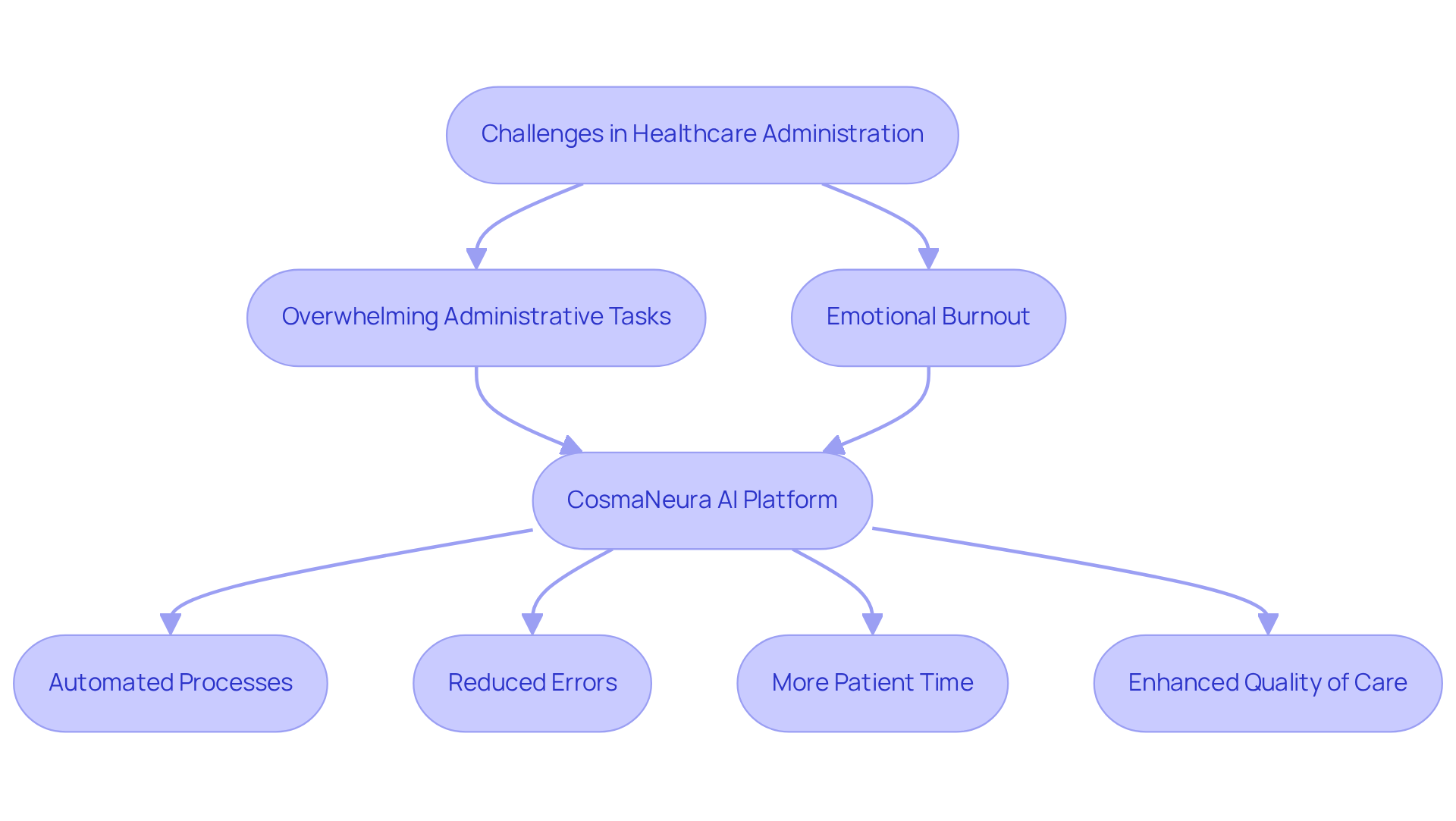
Standardized Template Formats: Ensuring Consistency in Patient Charts
The use of a patient chart template with standardized formats in medical records plays a vital role in ensuring that all necessary information is consistently captured. This uniformity significantly enhances the quality of clinical records, allowing healthcare providers to reference information quickly and minimizing the risk of omitting critical data. Have you ever considered how much a simple template can change the way we communicate? For instance, a study demonstrated that using standardized templates for neurovascular examinations improved record completeness from just 3.6% to an impressive 85.0%. Such improvements highlight how these templates can foster better communication among medical teams, ultimately leading to enhanced safety and quality of care.
Moreover, these templates are not one-size-fits-all; they can be customized to meet specific practice needs while still adhering to established standards. This flexibility empowers medical providers to maintain a high standard of record integrity, which is crucial for effectively managing individual patient care. Engaging clinicians in the development of these templates is essential, as their insights ensure that the formats align with practical clinical requirements. This collaboration fosters greater acceptance and utilization of the templates, making everyone’s job a little easier.
The benefits of extend beyond just improving record accuracy. They enhance inter-provider communication, streamline workflows, and ultimately improve overall efficiency in care delivery. By adopting a patient chart template, practices can enhance their documentation methods and contribute to improved patient outcomes and satisfaction. Isn’t it time we embraced these tools to support our commitment to quality care?
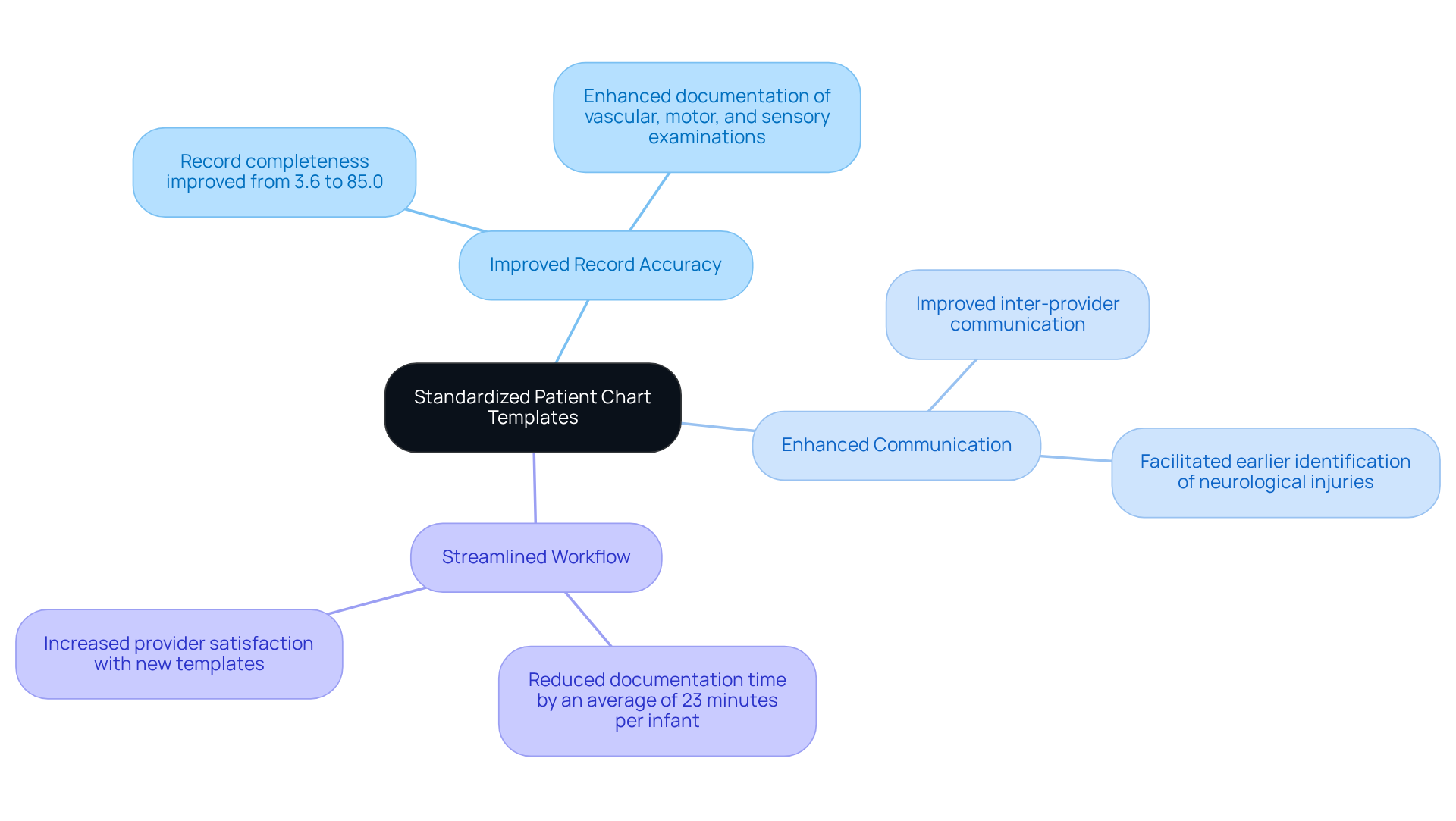
Essential Components: Key Elements of a Patient Chart Template
A well-organized chart template is essential for individuals in the healthcare field, as it directly impacts the efficiency of medical service provision. Key elements such as demographics, medical history, current medications, allergies, and treatment plans come together to provide a comprehensive overview of an individual's health condition. This thorough summary enables providers to make informed choices quickly. Have you considered how precise details like age and gender can customize care and ensure appropriate reimbursement? These factors significantly enhance the effectiveness and quality of service delivery.
Incorporating sections for progress notes and follow-up plans not only enhances the chart's utility but also supports continuous monitoring of an individual's condition. Research indicates that efficiently managing client demographics can lead to improved claim submissions and faster payments, which ultimately benefits healthcare organizations financially. Moreover, case studies highlight the value of comprehensive health records in fostering improved outcomes. By enabling personalized care and promoting effective communication between caregivers and individuals, we can nurture a supportive healthcare environment.
The inclusion of these is foundational for informed decision-making in clinical practice. They are also vital for compliance with regulations like HIPAA, which protect individual information. By meticulously documenting these components, medical professionals can enhance operational efficiency and improve overall care for individuals. How can you ensure that your practice is meeting these essential standards? Taking these steps not only supports your patients but also reinforces your commitment to quality care.
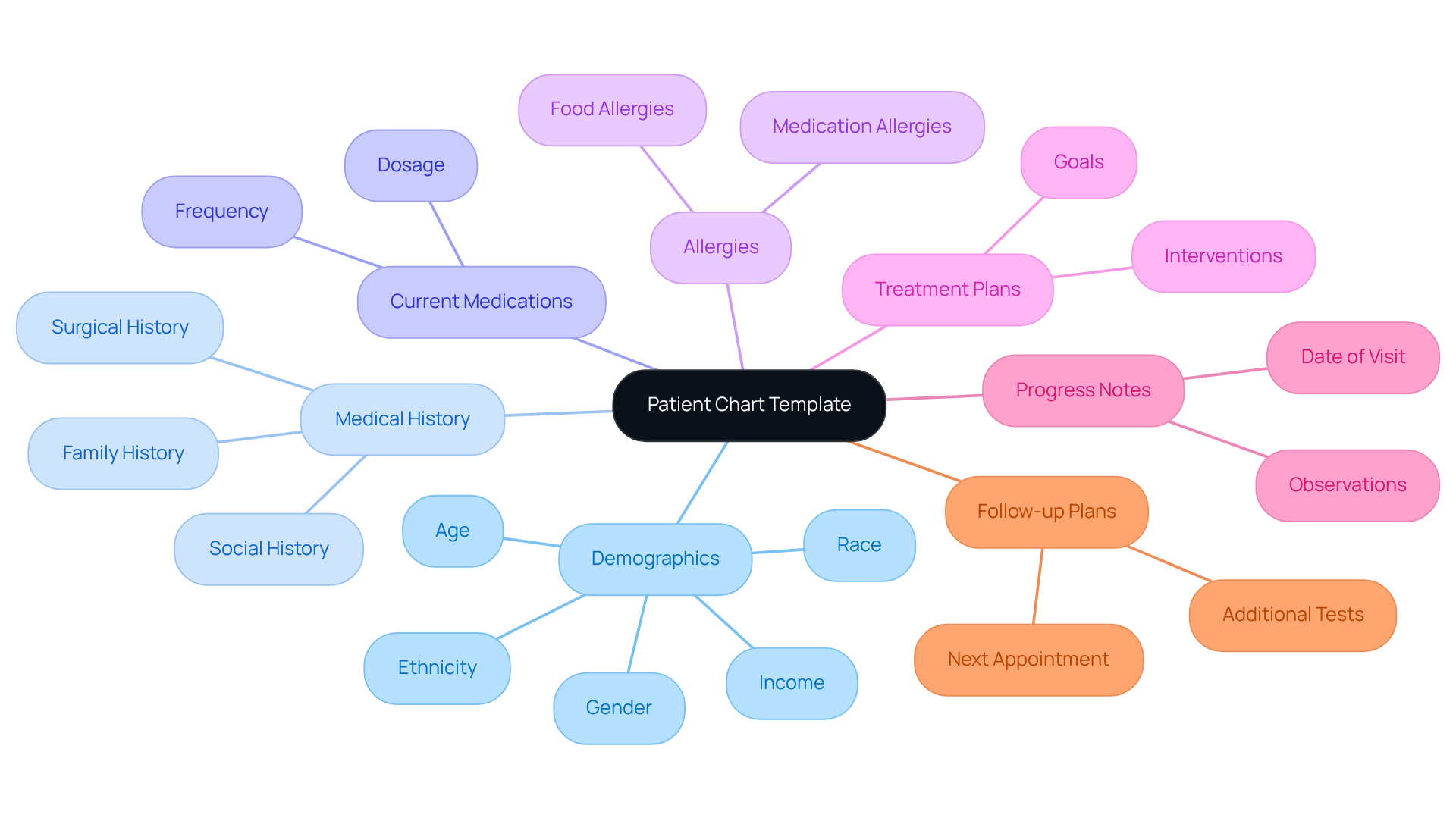
Team Documentation: Enhancing Collaboration in Patient Care
Establishing team record-keeping practices can significantly alleviate the emotional burdens faced by healthcare professionals. Have you ever felt overwhelmed by the sheer volume of administrative tasks? This collaborative approach allows team members to share responsibilities in recording client information, fostering a sense of collective accountability. Not only does this improve the accuracy of records, but it also enables providers to reclaim valuable hours previously spent on routine paperwork, allowing for more meaningful interactions with clients.
Imagine the positive impact on care quality when consistent record-keeping aids in treatment coordination and reduces the likelihood of errors. Research shows that nearly 75% of healthcare workers believe excessive record-keeping detracts from patient care, underscoring the urgent need for effective procedures. Moreover, shared records have been linked to increased patient engagement and adherence to treatment plans, showcasing their profound effect on overall care outcomes.
By embracing these practices, we can create a more compassionate healthcare environment. Let’s work together to streamline our processes and enhance the quality of care we provide. How can we support each other in overcoming these challenges? Your insights and experiences are invaluable as we .
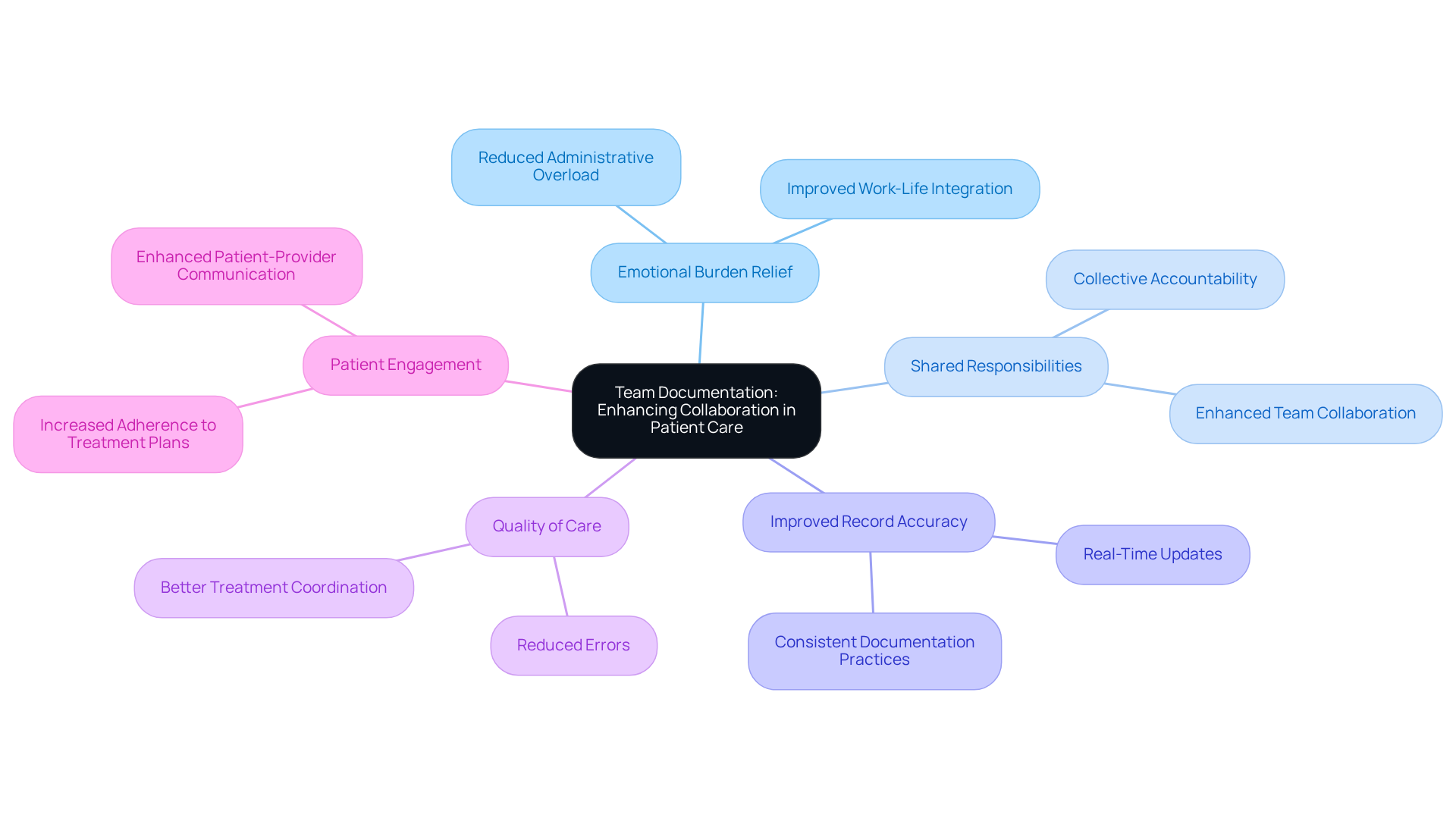
AI Medical Scribe: Accelerating Documentation Efficiency
In the demanding world of healthcare, providers often grapple with overwhelming administrative burdens that can detract from meaningful patient interactions. AI medical scribes emerge as a beacon of hope, transforming the record-keeping process by automating the transcription of client interactions in real-time. This innovative technology not only significantly reduces the time dedicated to administrative duties—research indicates that AI scribes can cut record-keeping time by approximately five minutes during a typical 30-minute visit—but also enhances the accuracy of clinical notes.
By alleviating this administrative burden, AI scribes create space for more meaningful interactions between clinicians and patients, ultimately enriching the overall patient experience. Imagine the difference it makes when healthcare providers can focus more on their patients rather than paperwork. Furthermore, the integration of AI scribe technology has shown remarkable improvements in clinical documentation quality, with transcripts consistently achieving high scores on quality assessments.
These advancements streamline workflows and empower medical providers to deliver compassionate care, aligning seamlessly with the ethical standards cherished in . However, navigating regulatory challenges like HIPAA remains crucial, as these guidelines can lead to fragmentation within medical systems. This makes the role of AI scribes even more vital in fostering effective communication and coordination.
As we embrace these technological advancements, let us reflect on how they can alleviate the emotional strain on healthcare providers and enhance the care we offer to our patients. Together, we can create a more compassionate and efficient healthcare environment.
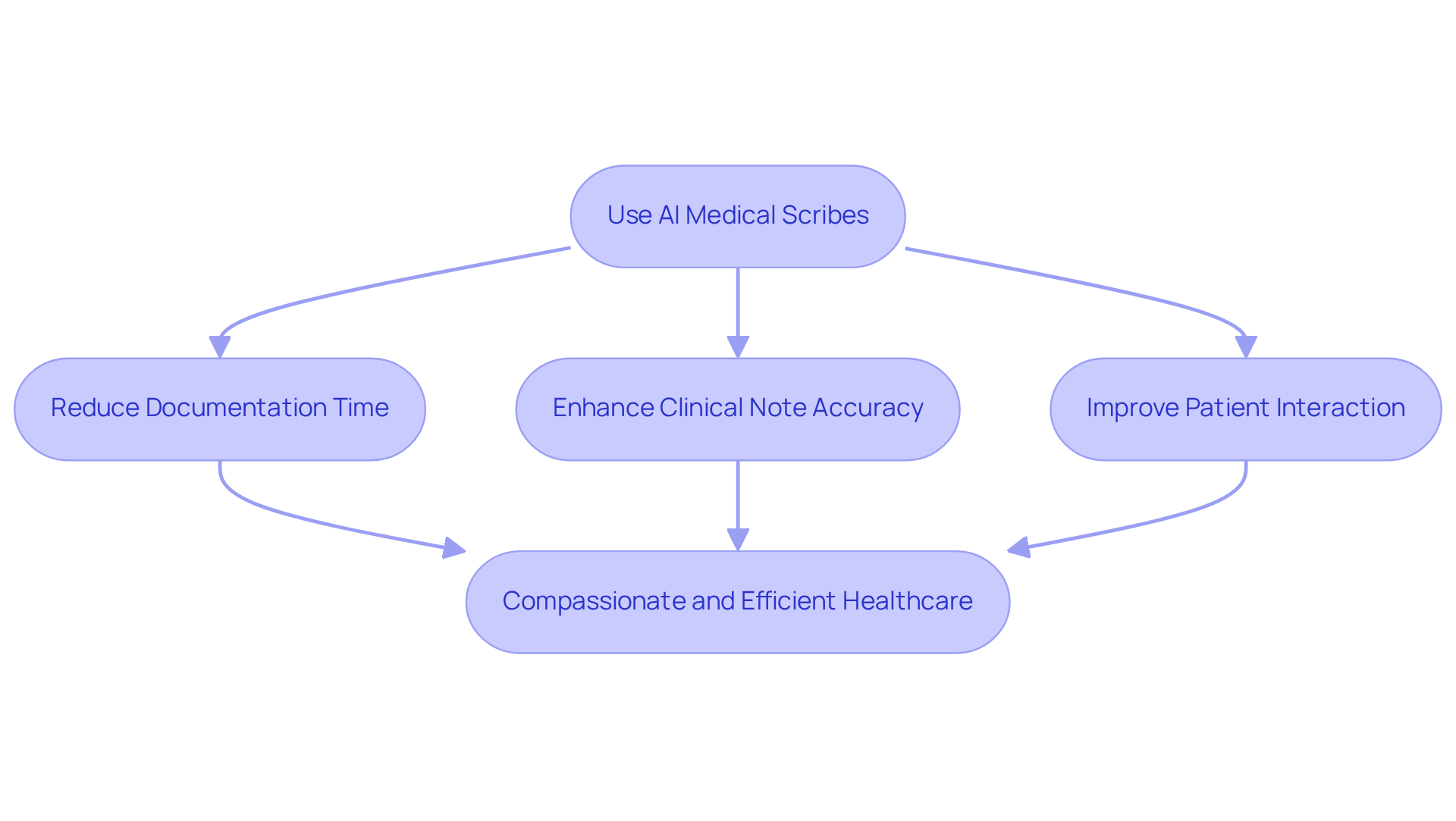
Clarity and Conciseness: The Cornerstones of Effective Patient Charts
In the demanding world of healthcare, clarity and conciseness in a patient chart template are essential. Have you ever felt overwhelmed by administrative burdens? Effective record-keeping can ease that burden, allowing for better communication among healthcare providers. Research shows that health professionals who prioritize clear record-keeping methods are 1.4 times more likely to communicate routine practices effectively, fostering collaboration that is vital for patient care.
Moreover, utilizing electronic systems for record-keeping enhances the chances of upholding good practices by 2.2 times compared to manual forms. This clarity not only improves communication but also significantly influences patient outcomes. Efficient record-keeping is linked to better adherence to treatment plans, which ultimately leads to greater patient satisfaction.
Consider a study that found effective verbal and non-verbal communication strategies positively impacted patient-centered outcomes. This underscores the importance of using a patient chart template for clear documentation in medical environments. By ensuring that the patient chart template is easy to read and comprehend, healthcare providers can facilitate better interactions. This not only enhances the quality of care but also promotes client safety.
Let’s commit to improving our documentation practices. Together, we can create a more compassionate and for everyone.
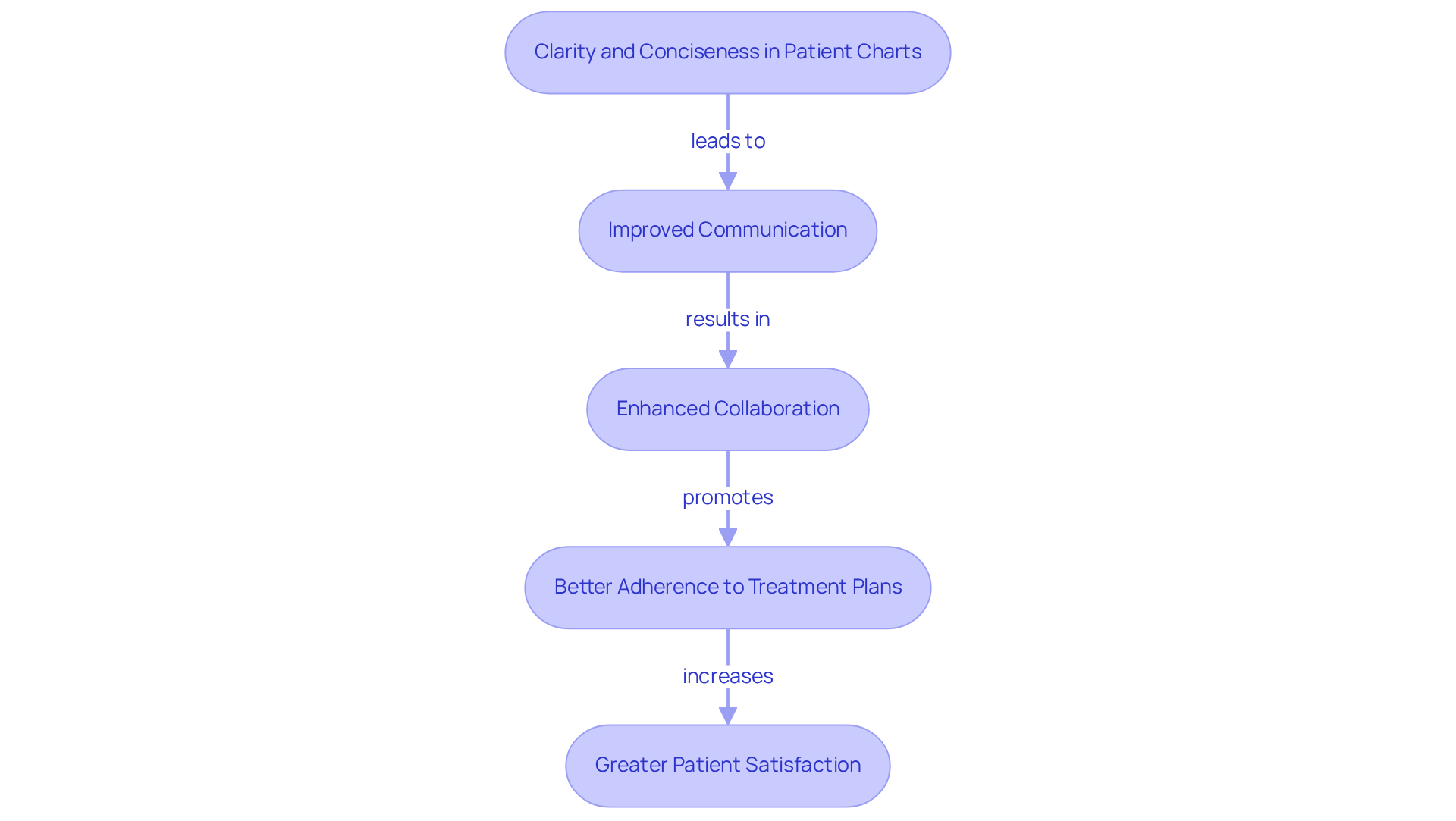
Telehealth Integration: Adapting Patient Charts for Remote Care
Modifying health records for telehealth is vital for facilitating effective remote consultations. Have you ever considered how challenging it can be for healthcare providers to adapt to this new landscape? Key features to include are:
- Video conferencing notes
- Digital consent forms
These features help maintain comprehensive records of virtual visits. This integration not only ensures continuity of care but also enhances patient involvement and satisfaction.
Data shows that 76% of primary care doctors believe they can deliver comparable quality of service during telemedicine appointments. This highlights the importance of a well-organized patient chart template in supporting remote medical care. Moreover, including digital consent forms simplifies the process, making it easier for individuals to understand their rights and the nature of the care they receive.
As telehealth continues to expand, with an estimated market worth of $559.52 billion by 2027, utilizing a patient chart template will be crucial in enhancing service delivery and improving outcomes for individuals. Together, we can embrace these changes to better and ensure that every patient feels valued and understood.
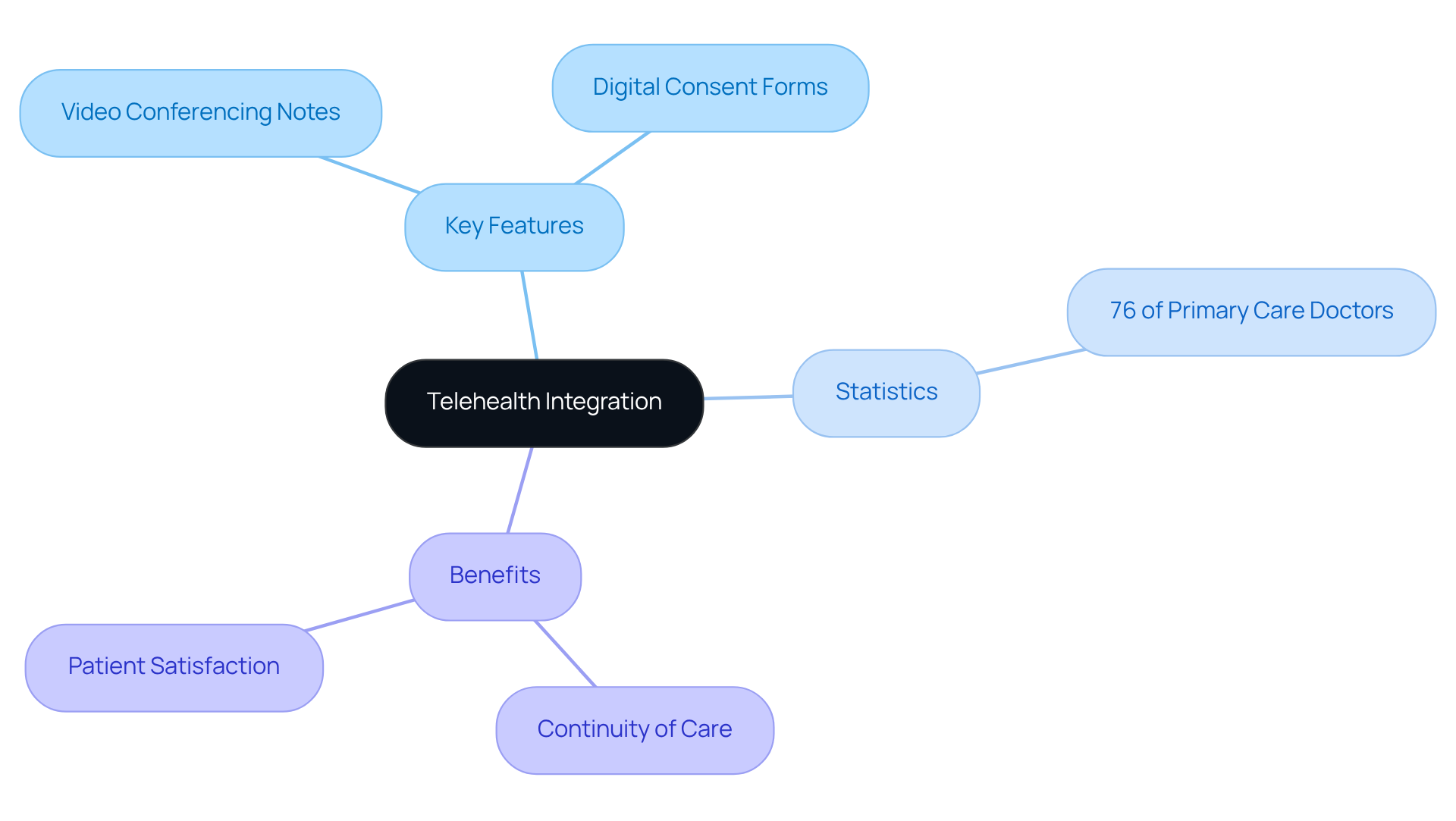
Efficient Chart Writing: Templates That Save Time
Healthcare professionals often face overwhelming administrative burdens that can detract from their ability to provide compassionate care. Effective patient chart templates serve as crucial resources in alleviating this challenge, significantly reducing the time spent on record-keeping. The patient chart template incorporates pre-filled sections for common client information, customizable fields, and seamless integration with electronic health records, empowering practitioners to complete charts swiftly and eliminating the need to start from scratch.
This efficient approach not only accelerates the documentation process but also allows providers to dedicate more time to caring for individuals, addressing the pressing issue of . Studies reveal that utilizing structured templates can lead to time savings of up to 45% in documentation tasks. Imagine reclaiming valuable hours previously consumed by administrative duties—time that can be redirected towards patient care.
Moreover, the inclusion of pre-filled sections enhances the thoroughness of recorded information, ensuring that essential data is captured accurately and efficiently. By harnessing the power of generative AI within these templates, healthcare organizations can automate repetitive tasks, such as data entry and creating summaries for individuals, further streamlining administrative processes.
Overall, the use of these time-saving templates fosters a more efficient workflow, ultimately elevating the standard of care provided to individuals. Healthcare professionals are encouraged to explore and implement these innovative patient chart templates. By doing so, they can enhance their practice and improve client outcomes. Are you ready to take the next step towards a more efficient and compassionate approach to healthcare?
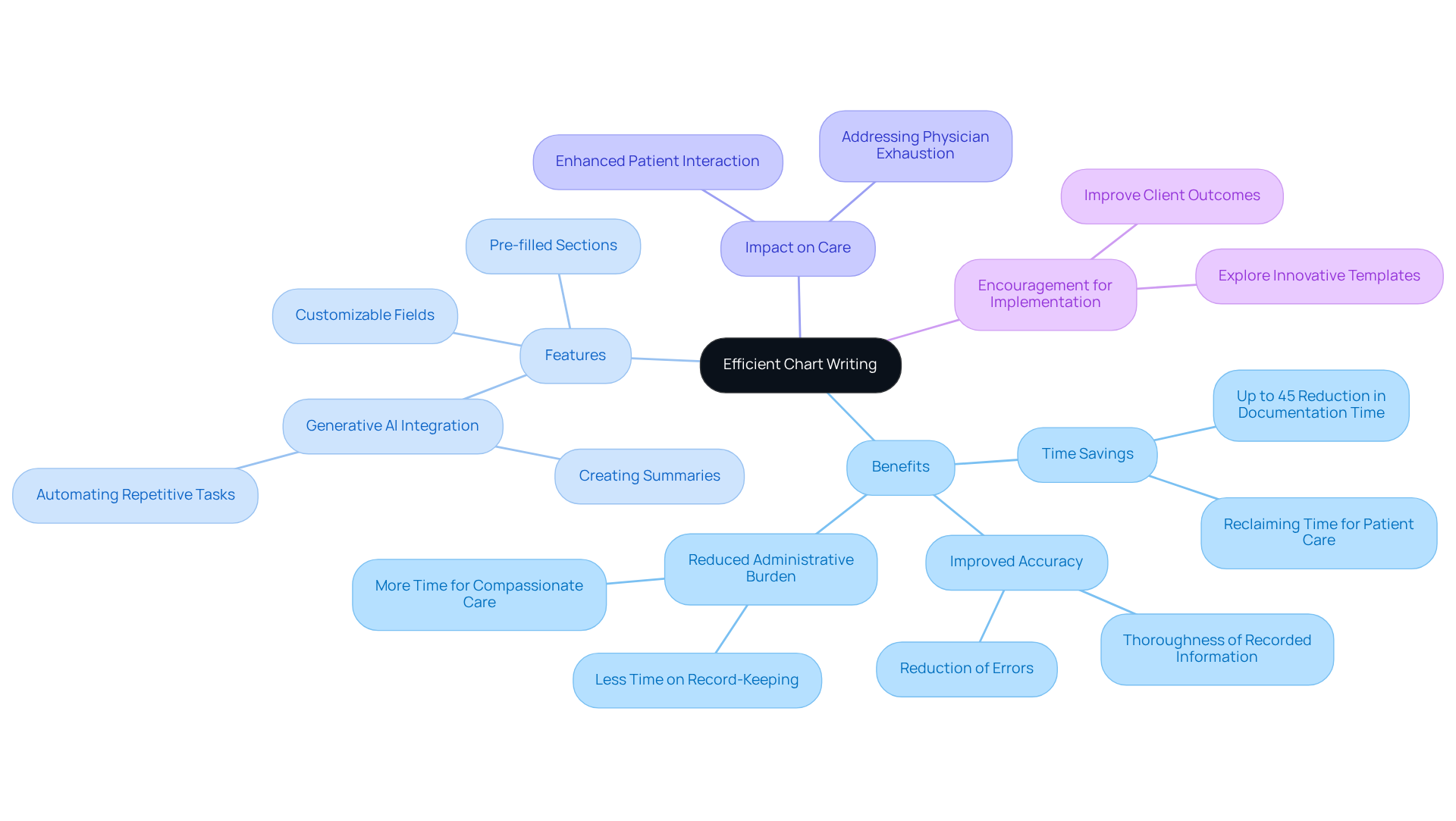
Customization Options: Tailoring Patient Chart Templates to Provider Needs
Customization choices in the patient chart template empower providers to adapt their records to meet specific practice needs and workflows. This flexibility allows for the inclusion of relevant fields and sections that align with their clinical focus, such as custom metrics and diagnostic guidance tailored to their specialties. As a result, usability is enhanced, and the record-keeping process becomes more straightforward.
Have you ever felt overwhelmed by administrative duties? Medical experts have observed that using a patient chart template not only boosts efficiency but also improves accuracy, enabling clinicians to focus more on patient care rather than paperwork. Case studies reveal that practices utilizing a patient chart template achieve significant improvements in workflow, which leads to greater job satisfaction and enhanced outcomes for patients.
Moreover, pilot testing of CosmaNeura's with physicians has shown that by prioritizing customization and leveraging AI tools, medical professionals can create a more efficient documentation system. This system aligns with their unique operational requirements while respecting Catholic teachings. By embracing these innovations, healthcare providers can transform their practices and foster a more compassionate care environment.
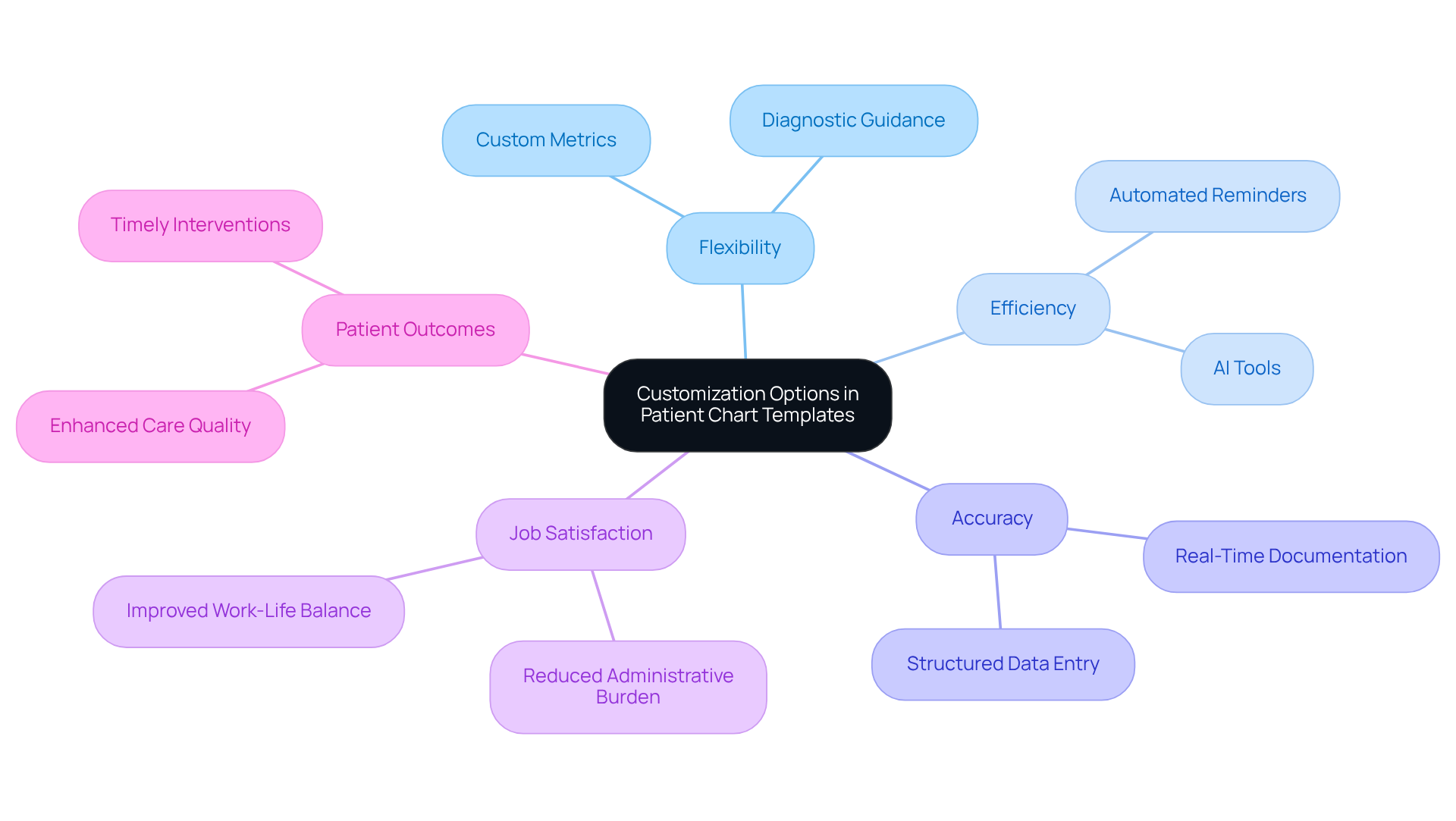
Billing Optimization: Enhancing Revenue Management in Patient Charts
Incorporating billing optimization capabilities into patient records is essential for improving revenue management in the medical field. Healthcare providers face increasing expenses that burden both practitioners and patients. How can we address this challenge? AI-driven tools can suggest appropriate billing codes and track billing history, enabling providers to maximize their revenue potential while ensuring fair compensation for the care they deliver.
For example, medical organizations that have implemented AI solutions have reported notable enhancements in billing precision and efficiency. Studies indicate that up to 90% of claim denials are preventable with improved front-end processes like accurate coding and eligibility verification. This underscores the importance of these tools in alleviating financial burdens.
Moreover, AI-driven billing optimization not only improves financial outcomes but also enhances operational efficiency. By reclaiming several hours per day for clinicians through the automation of routine administrative tasks, we can significantly impact patient care. Auburn Community Hospital, for instance, experienced a 50% reduction in discharged-not-final-billed cases and a more than 40% increase in coder productivity after implementing AI-driven revenue cycle management solutions.
This illustrates the tangible advantages of these technologies in transforming medical service delivery. By proactively addressing billing processes, healthcare providers can enhance their financial performance while focusing on delivering quality patient care. Ultimately, this contributes to a more . How can we work together to embrace these advancements for the benefit of both providers and patients?
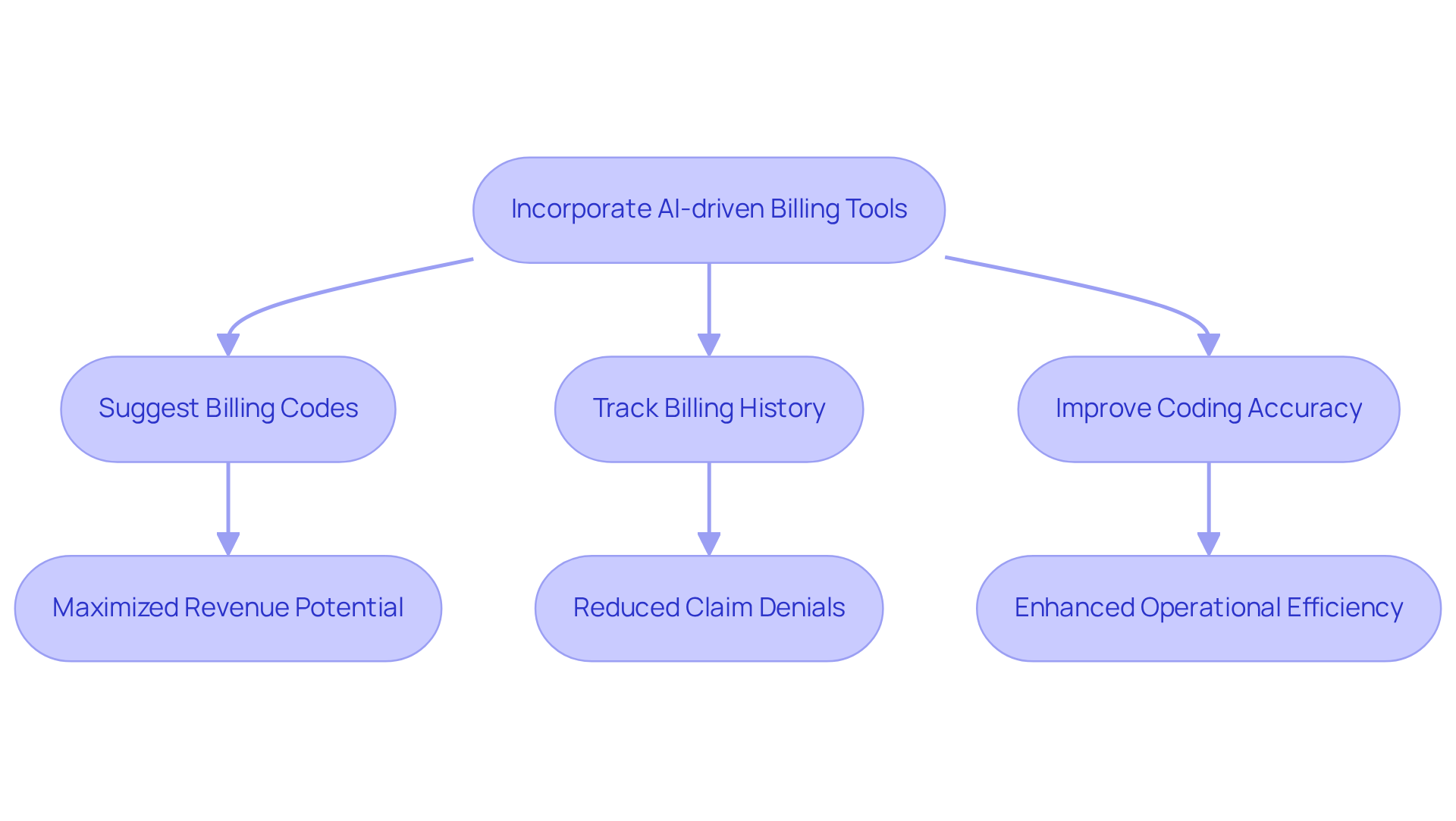
Conclusion
In today's healthcare landscape, the significance of a well-structured patient chart template is profound. Healthcare providers face emotional challenges daily, often overwhelmed by administrative burdens that detract from their ability to deliver compassionate care. By integrating essential features such as standardization, clarity, and customization, they can enhance operational efficiency and redirect their focus toward what truly matters: quality patient care.
Consider the advancements in AI technology, like those offered by CosmaNeura. These innovations streamline processes, allowing practitioners to reclaim valuable time and alleviate administrative pressures. Imagine how much more effective care could be with less time spent on paperwork and more on patient interaction.
Key points throughout this discussion highlight:
- The necessity of standardized formats for improved communication
- The importance of essential components like demographics and treatment plans
- The transformative role of AI medical scribes in enhancing documentation efficiency
Collaborative documentation practices foster teamwork and elevate patient engagement. Moreover, integrating telehealth features ensures continuity of care in our increasingly digital world.
As the healthcare industry evolves, embracing these innovative practices and technologies is not just beneficial; it’s crucial. Providers must prioritize developing patient chart templates that meet regulatory standards while catering to the unique needs of each practice. By doing so, they create a more supportive environment for themselves and their patients.
This commitment ultimately leads to improved health outcomes and greater satisfaction. Let’s take action together—invest in these solutions and transform the way we care for our patients. Together, we can foster a healthcare environment that is not only efficient but also compassionate and effective.




